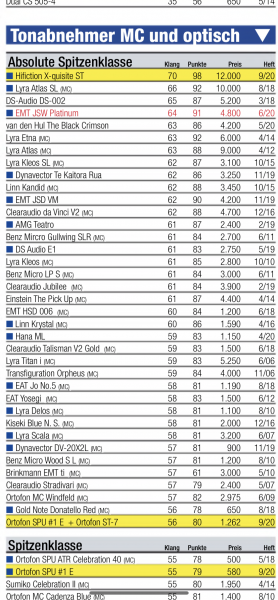Anyone heard the X-quisite Cartridge from Thales?
- Thread starter shakti
- Start date
You are using an out of date browser. It may not display this or other websites correctly.
You should upgrade or use an alternative browser.
You should upgrade or use an alternative browser.
To my ears it doesn’t sound like any EMT I’ve listened to.I heard X-quisite. if you like the sound of EMT cartridges it's a clear step up in terms of definition and finesse but less dynamism.
Not sure what you mean by “dynamism”.
I meant JSD Platinum or others. I like EMT cartridges and heard all of them. I used EMT TSD 15N SFL for a long time.To my ears it doesn’t sound like any EMT I’ve listened to.
Not sure what you mean by “dynamism”.
I’ve owned the XSD-15 SFL and listening once to a JSD Platinum.I meant JSD Platinum or others. I like EMT cartridges and heard all of them. I used EMT TSD 15N SFL for a long time.
IMHO, Both sound nothing like the X-quisite.
Is there a typo in the list for EMT; "JSD" or "JSW" Platinum?
Read M. Fremer’s column on September issue of Stereophile.any updates on opinions on the X-Quisite?
apart from his review.Read M. Fremer’s column on September issue of Stereophile.
yes. it’s a kind of opposite of the review he made a couple of months before. he recommends dedicated SUT for the solution.apart from his review.
Unfortunately I had still no chance to listen to the
X-Quiste cartridges
until now in my personal set up,
so I decided to geta ST version of the cartridge to personally find out, if the performance fits my taste.
In the meantime I heard the X-quisite cart in Demoes and at a customer home, but with unfamiliar set ups.
But still I was able to prefer the ST version.
Within the next weeks I will get the cartridge and I will continue this thread about my findings!
Really looking forward to this, carts in this segment are always something special
X-Quiste cartridges
until now in my personal set up,
so I decided to geta ST version of the cartridge to personally find out, if the performance fits my taste.
In the meantime I heard the X-quisite cart in Demoes and at a customer home, but with unfamiliar set ups.
But still I was able to prefer the ST version.
Within the next weeks I will get the cartridge and I will continue this thread about my findings!
Really looking forward to this, carts in this segment are always something special
Last edited:
After having spent some hours with the X-quisite ST cartridge, I have to say, that the cart plays according to the given price point,
but to arrive at this performance level, it took some time.
The Cart is very heavy (16,6g) and not every tonearm can host this weight with the standard counter weight.
My favorite exchangeable headshells are in the 18g league, which adds up to nearly 35g.
With the given compliance of 12, this is potentially again too much, even if the counterweight can handle,
but the most tonearms will have than a too high effective mass.
As I heard the x-quisite carts very good and very bad on similar Phonostage set ups. The difference in performance must be found in the individual tonearm combinations. The difference in performance was mainly in the upper frequency region. In some set ups this was similar to some of my vdh Colibri experience, too bright and with a high focus on sibilants. On the other hand I had a warmer sound with a focus on natural meds / voices. With the Colibri this was very often a function of the cartridge body (and the adjustment as such).
Coming from there, I tried to understand the X-quisite body construction a little better.
It seems, that Michael Huber has given the body (similar to vdh and some others) a special attention,
as he is offering 3 different kinds of body.
A lighter alloy, a titanium and a brass body is on offer, all with a rosewood cover.
The weight goes from around 14,8g for the alloy over around 17g for the titanium to nearly 21g for the brass version,
which is also the most expensive version.
Assuming, that Design and voicing was mainly done using the Thales Statement tonearm, it became obvious, that the cartridge Design might include the effect of the full covering alloy subplatter, which is part of the Thales headshell/tonearm Design.
The thin rosewood platter than becomes the interface between the 3 different cartridge materials on offer and the subplatter, which can be seen on this picture (the black part above the cartridge):
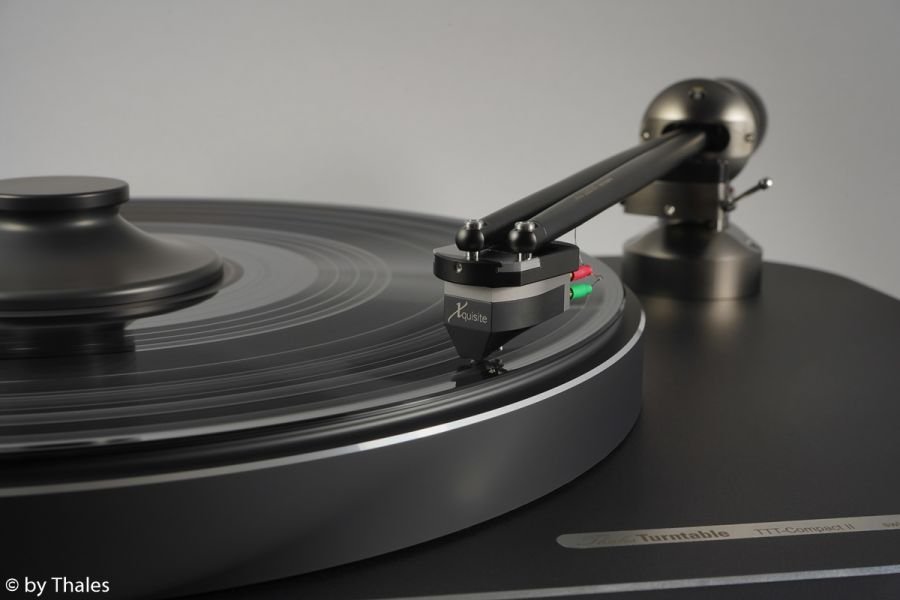
The Thales Statement tonearm is specified with an effective mass of 25g, which is relatively high.
Not too many tonearms would be able support the X-quisite with a similar specification, specially, as the cart is very long and slim as well. So easily you will have a conflict with the headshell wire connectors in some tonearms / Headshell as well as with the lowest point you can adjust VTA with given turntable / tonearm configuration.
I was even thinking at the beginning, that I might add a headshell spacer to copy/paste the damping function and the height increase of the Thales subplatter.
Coming from the effective weight need for a heavier tonearm I have chosen the Ganz MH-1200s 12" Tonarm.
But the original Glanz Headshell had not enough contact to the top of the cart to copy the original Thales Design.
The AS Arche had enough space for the headshell contacts, but only a little contact to the top of the cart.
Because of the airy Design, the Arche applied for the usage of an additional headshell spacer, I might will try this, if it works, the cart will fit potentially also in my AS Axiom tonearm (which has in my set up a VTA problem with the X-quisite cart dimension)
All of my Yamamoto Headshell were a little too short in the area of the headshell leads,
so finally I ended up with the OMA headshell using SAEC triple C headshell cables.
Good coverage of the Rosewood top and a comfortable distance to the headshell connector part.
The pure Graphite of the OMA headshell should give the X-quisite ST a perfect additional damping and the 13g of the OMA Headshell brings the total weight close to 30g, which is perfect for the Glanz tonearm
(as originally designed for the heavy Ortofon SPU carts).
As expected, the set up of the ST into the Glanz tonearm was straight forward and the first minutes of listening were already nice.
After some hours of playing the cart opened up and luckily the tonal balance was more on the neutral to warm side, than on the harsh and bright one. Seems, that the full contact dampening effect of the OMA Graphit headshell to the rosewood top is working fine.
Using Kondo SFZ (1:20) step up and Air Tight ATE 3011 Phonostage specially the midrange reminds me to the best Soundsmith carts, very natural and full of energy.
My expectation was, to find more of the classic EMT JSD house sound in terms of dynamic, but the X-Quisite ST is more more laid back, focussing on a real big stage for the musicians, giving them the space to breath.
The resolution as such is different and not so refined as with some of the diamond cantilever cartridges
( I used the Phasemation PP-5000 in the same position before)
but the complete picture shows a well balanced voicing, which invites for long hour listening.
Fortunately I had some Deutsche Grammophone Original Source Records new to my collection and the X-quisite ST
made them a listening pleasure.
To understand the X-Quisite ST even better, I will get a ceramic Headshell soon, which will change the damping by many criteria again. Looking forward to this. Always a great experience to get in contact with such a type of cutting edge components and to integrate them in a given set up , to learn and to understand the component to let them play at the best.
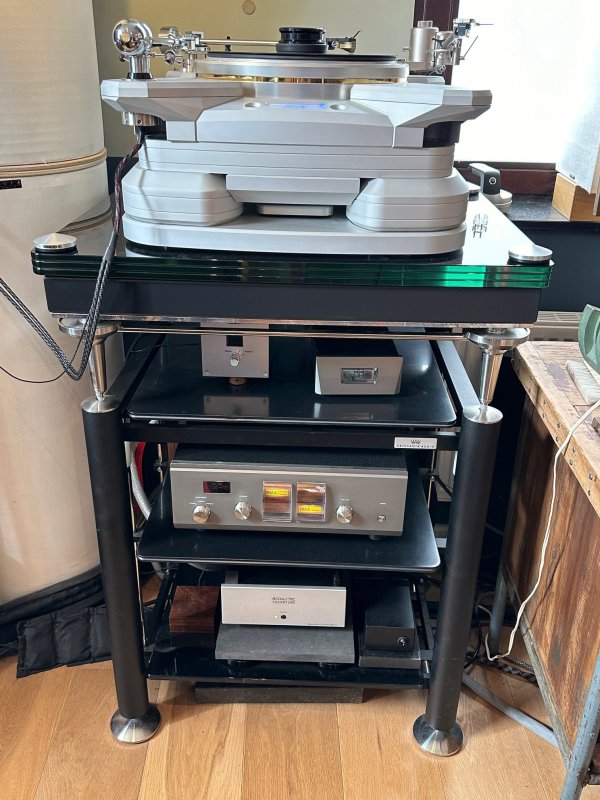
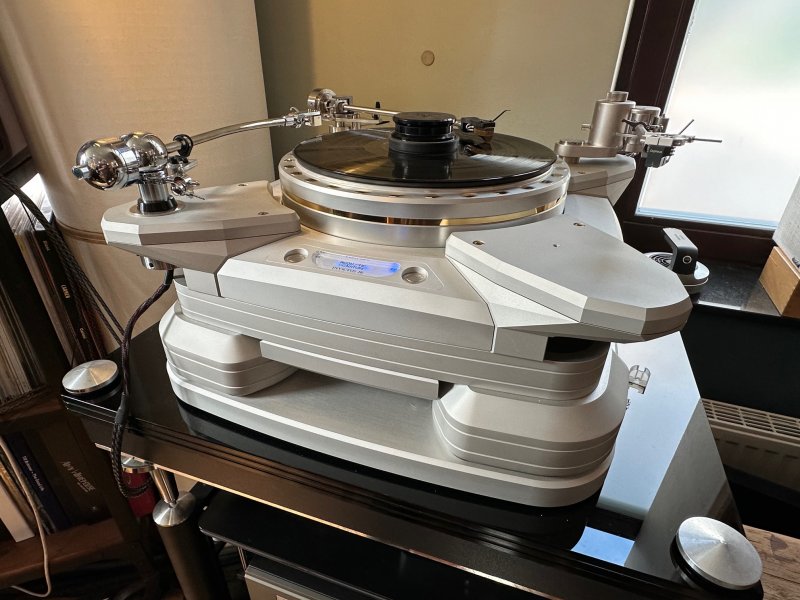
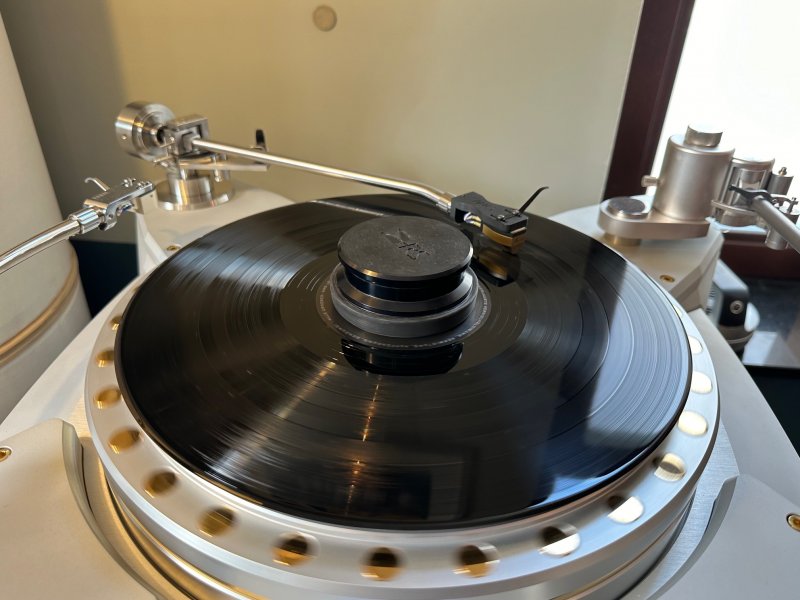
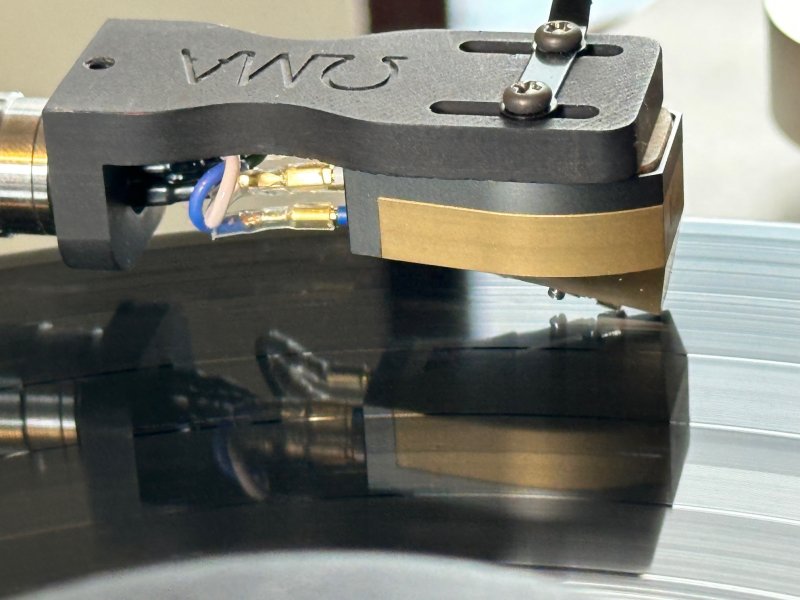
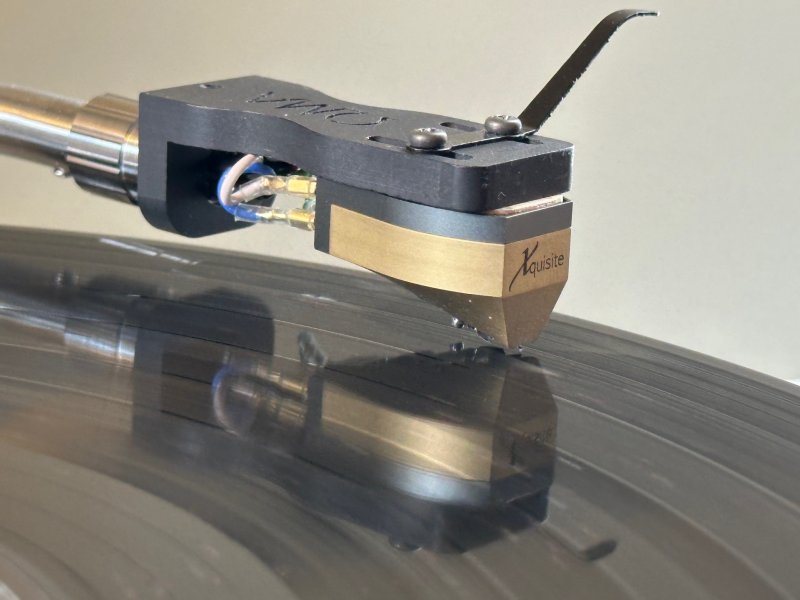
but to arrive at this performance level, it took some time.
The Cart is very heavy (16,6g) and not every tonearm can host this weight with the standard counter weight.
My favorite exchangeable headshells are in the 18g league, which adds up to nearly 35g.
With the given compliance of 12, this is potentially again too much, even if the counterweight can handle,
but the most tonearms will have than a too high effective mass.
As I heard the x-quisite carts very good and very bad on similar Phonostage set ups. The difference in performance must be found in the individual tonearm combinations. The difference in performance was mainly in the upper frequency region. In some set ups this was similar to some of my vdh Colibri experience, too bright and with a high focus on sibilants. On the other hand I had a warmer sound with a focus on natural meds / voices. With the Colibri this was very often a function of the cartridge body (and the adjustment as such).
Coming from there, I tried to understand the X-quisite body construction a little better.
It seems, that Michael Huber has given the body (similar to vdh and some others) a special attention,
as he is offering 3 different kinds of body.
A lighter alloy, a titanium and a brass body is on offer, all with a rosewood cover.
The weight goes from around 14,8g for the alloy over around 17g for the titanium to nearly 21g for the brass version,
which is also the most expensive version.
Assuming, that Design and voicing was mainly done using the Thales Statement tonearm, it became obvious, that the cartridge Design might include the effect of the full covering alloy subplatter, which is part of the Thales headshell/tonearm Design.
The thin rosewood platter than becomes the interface between the 3 different cartridge materials on offer and the subplatter, which can be seen on this picture (the black part above the cartridge):

The Thales Statement tonearm is specified with an effective mass of 25g, which is relatively high.
Not too many tonearms would be able support the X-quisite with a similar specification, specially, as the cart is very long and slim as well. So easily you will have a conflict with the headshell wire connectors in some tonearms / Headshell as well as with the lowest point you can adjust VTA with given turntable / tonearm configuration.
I was even thinking at the beginning, that I might add a headshell spacer to copy/paste the damping function and the height increase of the Thales subplatter.
Coming from the effective weight need for a heavier tonearm I have chosen the Ganz MH-1200s 12" Tonarm.
But the original Glanz Headshell had not enough contact to the top of the cart to copy the original Thales Design.
The AS Arche had enough space for the headshell contacts, but only a little contact to the top of the cart.
Because of the airy Design, the Arche applied for the usage of an additional headshell spacer, I might will try this, if it works, the cart will fit potentially also in my AS Axiom tonearm (which has in my set up a VTA problem with the X-quisite cart dimension)
All of my Yamamoto Headshell were a little too short in the area of the headshell leads,
so finally I ended up with the OMA headshell using SAEC triple C headshell cables.
Good coverage of the Rosewood top and a comfortable distance to the headshell connector part.
The pure Graphite of the OMA headshell should give the X-quisite ST a perfect additional damping and the 13g of the OMA Headshell brings the total weight close to 30g, which is perfect for the Glanz tonearm
(as originally designed for the heavy Ortofon SPU carts).
As expected, the set up of the ST into the Glanz tonearm was straight forward and the first minutes of listening were already nice.
After some hours of playing the cart opened up and luckily the tonal balance was more on the neutral to warm side, than on the harsh and bright one. Seems, that the full contact dampening effect of the OMA Graphit headshell to the rosewood top is working fine.
Using Kondo SFZ (1:20) step up and Air Tight ATE 3011 Phonostage specially the midrange reminds me to the best Soundsmith carts, very natural and full of energy.
My expectation was, to find more of the classic EMT JSD house sound in terms of dynamic, but the X-Quisite ST is more more laid back, focussing on a real big stage for the musicians, giving them the space to breath.
The resolution as such is different and not so refined as with some of the diamond cantilever cartridges
( I used the Phasemation PP-5000 in the same position before)
but the complete picture shows a well balanced voicing, which invites for long hour listening.
Fortunately I had some Deutsche Grammophone Original Source Records new to my collection and the X-quisite ST
made them a listening pleasure.
To understand the X-Quisite ST even better, I will get a ceramic Headshell soon, which will change the damping by many criteria again. Looking forward to this. Always a great experience to get in contact with such a type of cutting edge components and to integrate them in a given set up , to learn and to understand the component to let them play at the best.





| Steve Williams Site Founder | Site Owner | Administrator | Ron Resnick Site Owner | Administrator | Julian (The Fixer) Website Build | Marketing Managersing |






